Optical Properties of Ag Nanoparticle Arrays: Near-Field Enhancement and Photo-Thermal Temperature Distribution
Abstract
1. Introduction
2. Theories and Methods
2.1. Discrete Dipole Approximation Method
2.2. Thermal Green's Function Method
3. Results and Discussions
3.1. Optical Properties of Array Structure
3.1.1. The Influence of Particle Spacing
3.1.2. The Influence of Particle Radius
3.1.3. The Influence of Illumination Polarization
3.2. Photo-Induced Heating of Array Structure
4. Conclusions
Supplementary Materials
Author Contributions
Funding
Data Availability Statement
Acknowledgments
Conflicts of Interest
References
- Amendola, V.; Pilot, R.; Frasconi, M.; Marago, O.M.; Lati, M.A. Surface plasmon resonance in gold nanoparticles: A review. J. Phys. Condens. Matter 2017, 29, 203002. [Google Scholar] [CrossRef]
- Kelly, K.L.; Coronado, E.; Zhao, L.L.; Schatz, G.C. The optical properties of metal nanoparticles: The influence of size, shape, and dielectric environment. J. Phys. Chem. B 2003, 107, 668–677. [Google Scholar] [CrossRef]
- Sosa, I.O.; Noguez, C.; Barrera, R.G. Optical properties of metal nanoparticles with arbitrary shapes. J. Phys. Chem. B 2003, 107, 6269–6275. [Google Scholar] [CrossRef]
- Ross, M.B.; Mirkin, C.A.; Schatz, G.C. Optical properties of one-, two-, and three-dimensional array of plasmonic nanostructures. J. Phys. Chem. C 2016, 120, 816–830. [Google Scholar] [CrossRef]
- Manjavacas, A.; Zundel, L.; Sanders, S. Analysis of the limits of the near-field produced by nanoparticle arrays. ACS Nano 2019, 13, 10682–10693. [Google Scholar] [CrossRef]
- Luo, D.B.; Shi, B.; Zhu, Q.; Qian, L.L.; Qin, Y.P.; Xie, J.J. Optical properties of Au-Ag nanosphere dimer: Influence of interparticle spacing. Opt. Commun. 2020, 458, 124746. [Google Scholar] [CrossRef]
- Nie, S.M.; Emory, S.R. Probing single molecules and single nanoparticles by surface-enhanced Raman scattering. Science 1991, 275, 1102–1106. [Google Scholar] [CrossRef]
- Okamoto, K.; Niki, I.; Shvartser, A.; Narukawa, Y.; Mukal, T.; Scherer, A. Surface-plasmon-enhanced light emitters based on InGaN quantum wells. Nat. Mater. 2004, 3, 601–605. [Google Scholar] [CrossRef]
- Atwater, H.A.; Polman, A. Plasmonics for improved photovoltaic devices. Nat. Mater. 2010, 9, 205–213. [Google Scholar] [CrossRef]
- Herves, P.; Perez-Lorenzo, M.; Liz-Marzan, L.M.; Dzubiella, J.; Lu, Y.; Ballauff, M. Catalysis by metallic nanoparticles in aqueous solution: Model reactions. Chem. Soc. Rev. 2012, 41, 5577–5587. [Google Scholar] [CrossRef]
- Baffou, G.; Berto, P.; Urena, E.B.; Quidant, R.; Monneret, S.; Polleux, J.; Rigneault, H. Photoinduced heating of nanoparticle arrays. ACS Nano 2013, 7, 6478–6488. [Google Scholar] [CrossRef]
- Baffou, G.; Cichos, F.; Quidant, R. Applications and challenges of thermoplasmonics. Nat. Mater. 2020, 19, 946–958. [Google Scholar] [CrossRef]
- Boyer, D.; Tamarat, P.; Maali, A.; Lounis, B.; Orrit, M. Photothermal imaging of nanometer-sized metal particles among scatterers. Science 2002, 297, 1160–1163. [Google Scholar] [CrossRef]
- Pitsillides, C.M.; Joe, E.K.; Wei, X.B.; Anderson, R.R.; Lin, C.P. Selective cell targeting with light-absorbing microparticles and Nanoparticles. Biophys. J. 2003, 84, 4023–4032. [Google Scholar] [CrossRef]
- Baffou, G. Thermoplasmonics: Heating Metal Nanoparticles Using Light; Cambridge University Press: Cambridge, UK, 2017. [Google Scholar] [CrossRef]
- Ali, M.R.; Wu, L.; EI-Sayed, M.A. Gold nanoparticle-assisted plasmonic photothermal therapy advances towards clinical application. J. Phys. Chem. C 2019, 123, 15375–15393. [Google Scholar] [CrossRef]
- Guerrero, A.R.; Hassan, N.; Escobar, C.A.; Albericio, F.; Kogan, M.J.; Araya, E. Gold nanoparticles for photothermally controlled drug release. Nanomedicine 2014, 9, 2023–2039. [Google Scholar] [CrossRef]
- Chen, M.J.; He, Y.R.; Zhu, J.Q.; Kim, D.R. Enhancement of photo-thermal conversion using gold nanofluids with different particle sizes. Energy Convers. Manag. 2016, 112, 21–30. [Google Scholar] [CrossRef]
- Luo, M.G.; Zhao, J.M.; Liu, L.H.; Antezza, M. Photothermal behavior for two-dimensional nanoparticle ensembles: Multiple scattering and thermal accumulation effects. Phys. Rev. B 2022, 105, 235431. [Google Scholar] [CrossRef]
- Draine, B.T.; Flatau, P.J. Diserete-dipole approximation for periodic targets: Theory and tests. J. Opt. Soc. Am. A 2008, 25, 2693–2703. [Google Scholar] [CrossRef]
- Flatau, P.J.; Draine, B.T. Fast near field calculations in the discrete dipole approximation for regular rectilinear grids. Opt. Express 2012, 20, 1247–1252. [Google Scholar] [CrossRef]
- Siahpoush, V.; Ahmadi-kandjani, S.; Nikniazi, A. Effect of plasmonic coupling on photothermal behavior of random nanoparticles. Opt. Commun. 2018, 420, 52–58. [Google Scholar] [CrossRef]
- Bohren, C.F.; Huffman, D.R. Absorption and Scattering of Light by Small Particles; John Wiley & Sons, Inc.: New York, NY, USA, 1998; pp. 69–81. [Google Scholar] [CrossRef]
- Johnson, P.B.; Christy, R.W. Optical constants of the noble metals. Phys. Rev. B 1972, 6, 4370–4379. [Google Scholar] [CrossRef]
- Metwally, K.; Mensah, S.; Baffou, G. Isosbestic thermoplasmonic nanostructures. ACS Photonics 2017, 4, 1544–1551. [Google Scholar] [CrossRef]
- Geraci, G.; Hopkins, B.; Miroshnichenko, A.E.; Erkihun, B.; Neshev, D.N.; Kivshar, Y.S.; Maier, S.A.; Rahmani, M. Polarisation-independent enhanced scattering by tailoring asymmetric plasmonic systems. Nanoscale 2016, 8, 6021–6027. [Google Scholar] [CrossRef]
- Baffou, G.; Urena, E.B.; Berto, P.; Monneret, S.; Quidant, R.; Rigneault, H. Deterministic temperature shaping using plasmonic nanoparticle assemblies. Nanoscale 2014, 6, 8984–8989. [Google Scholar] [CrossRef]
- Zhu, M.; Baffou, G.; Meyerbroker, N.; Polleux, J. Micropatterning thermoplasmonic gold nanoarrays to manipulate cell adhesion. ACS Nano 2012, 6, 7227–7233. [Google Scholar] [CrossRef]
- Li, Y.F.; Liu, X.D.; Li, J.; Wu, J. Photothermal forces enhanced by nanoneedle array for nanoparticle manipulation. Opt. Commun. 2020, 454, 124439. [Google Scholar] [CrossRef]
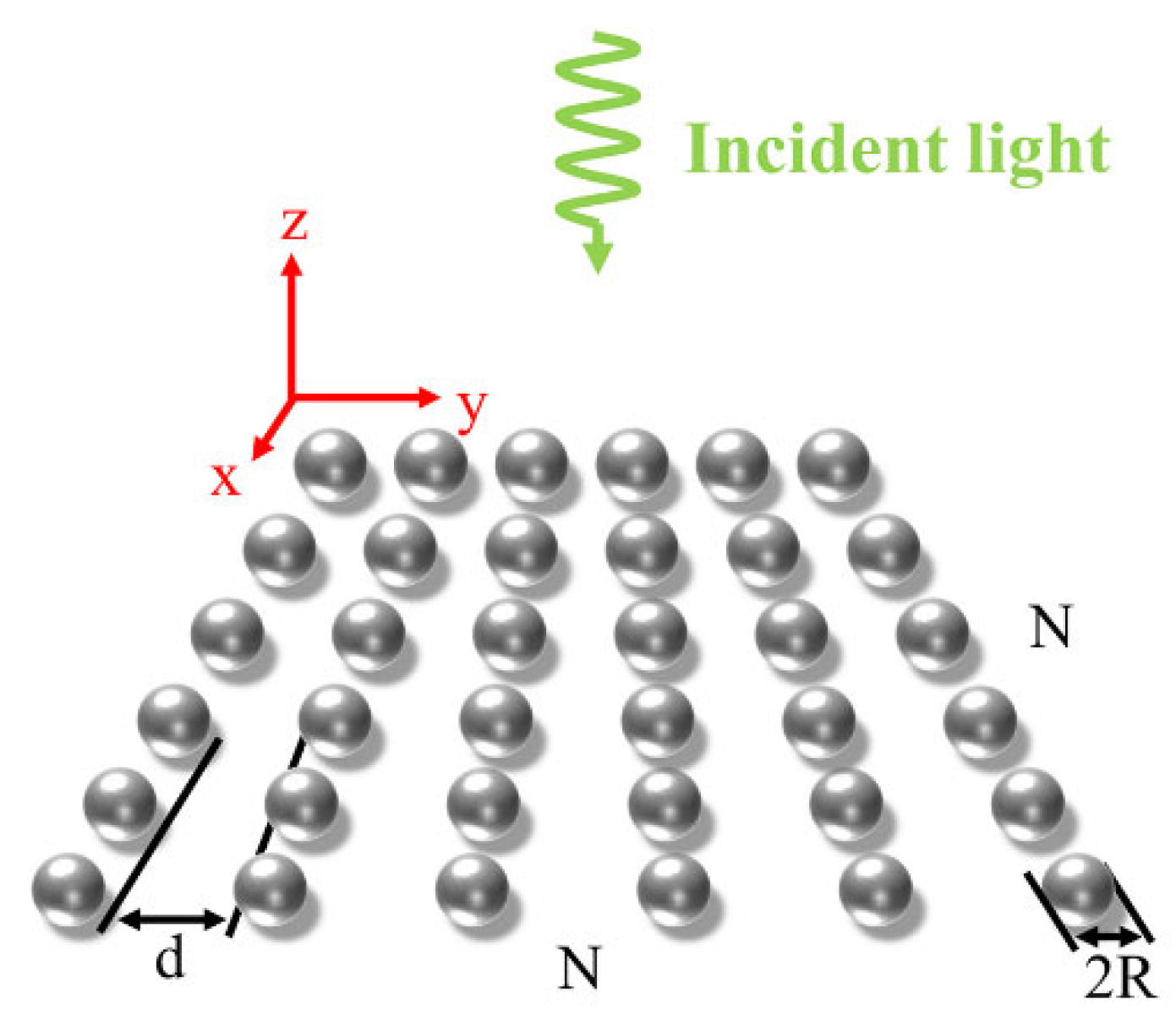
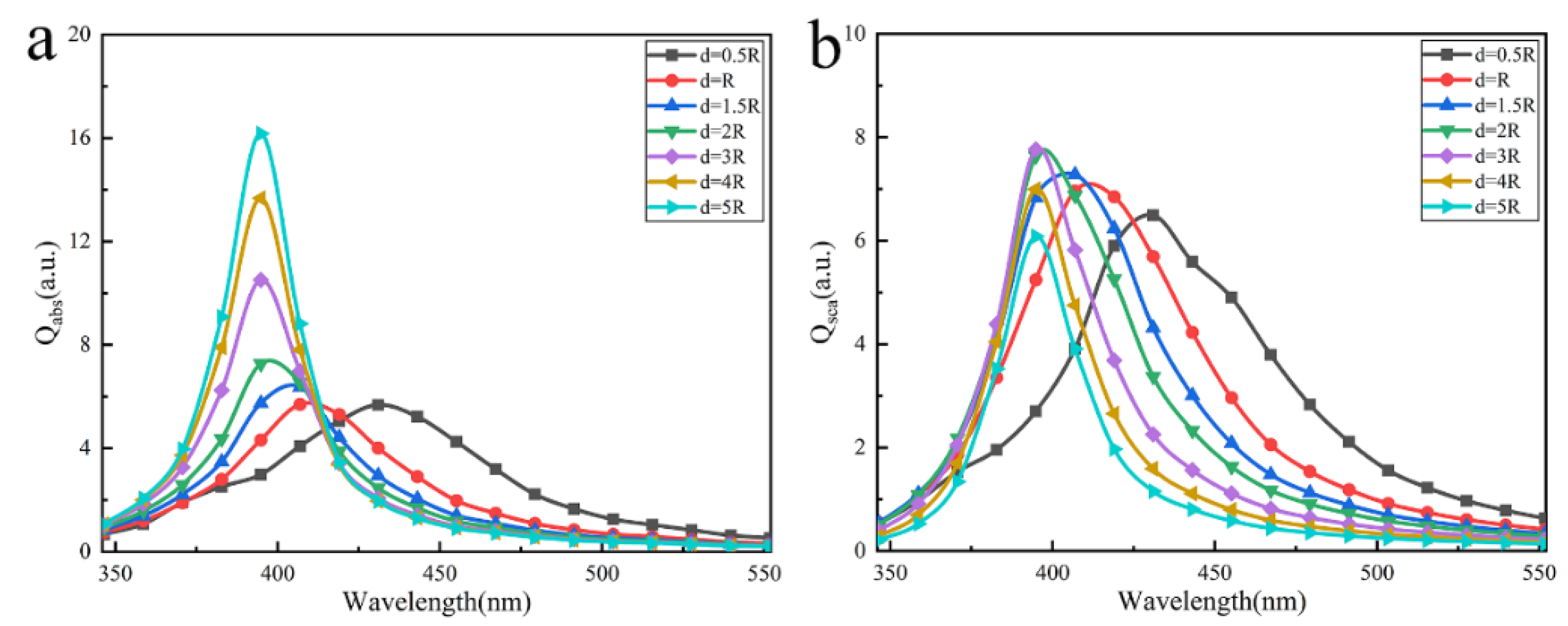

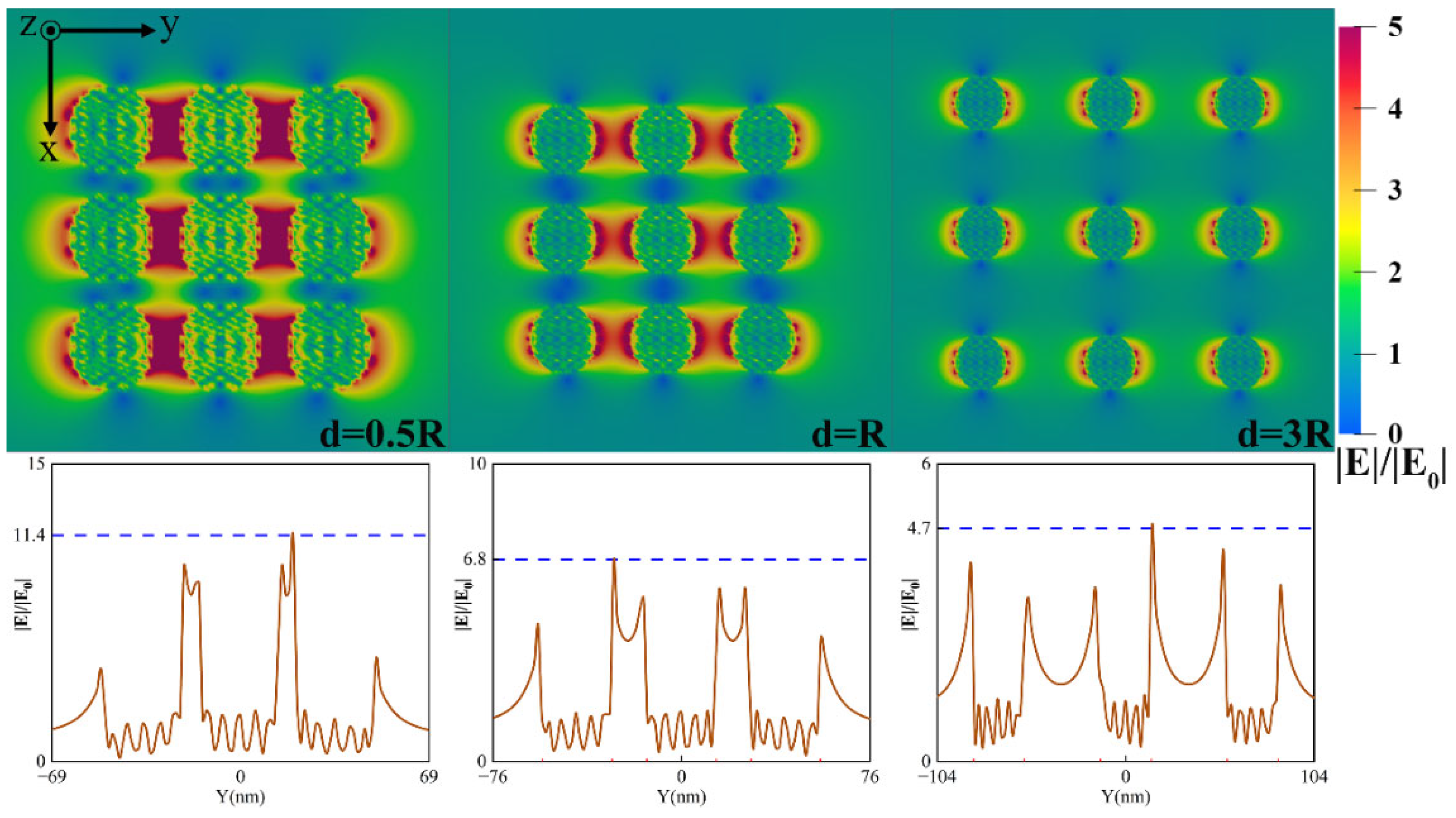
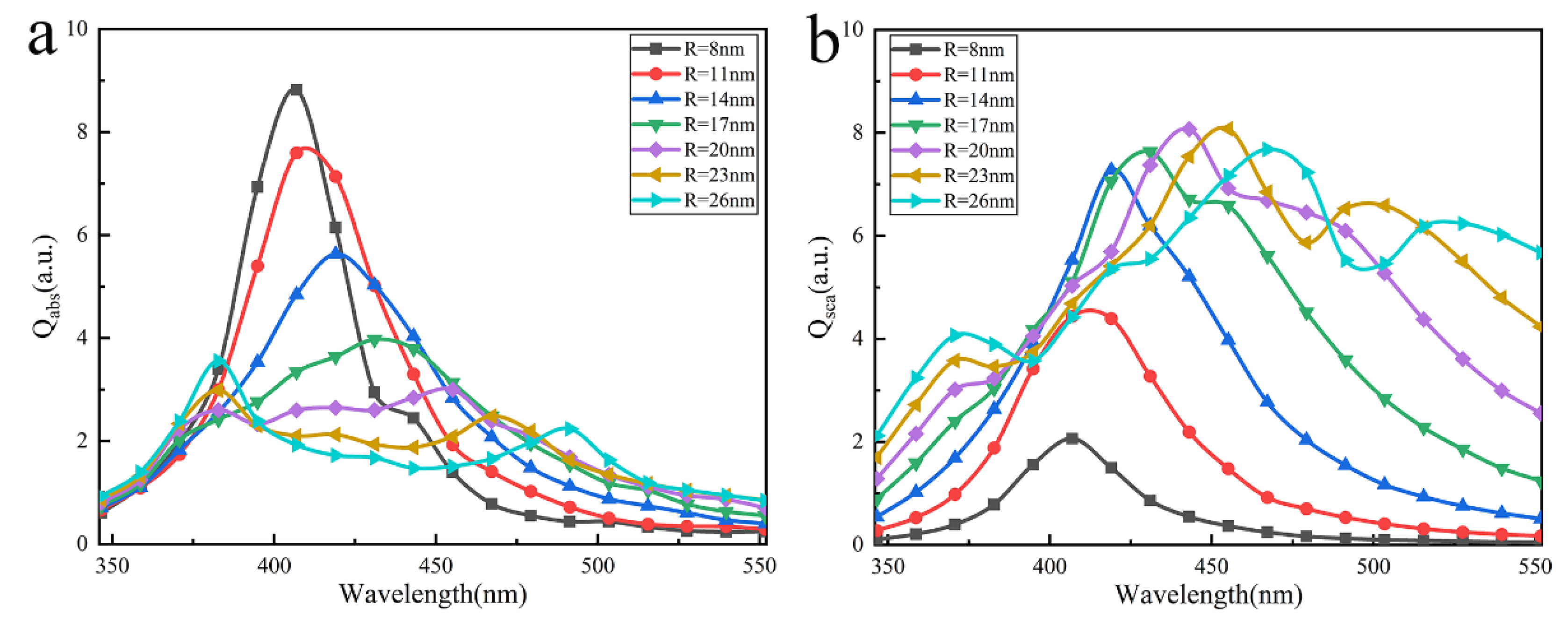
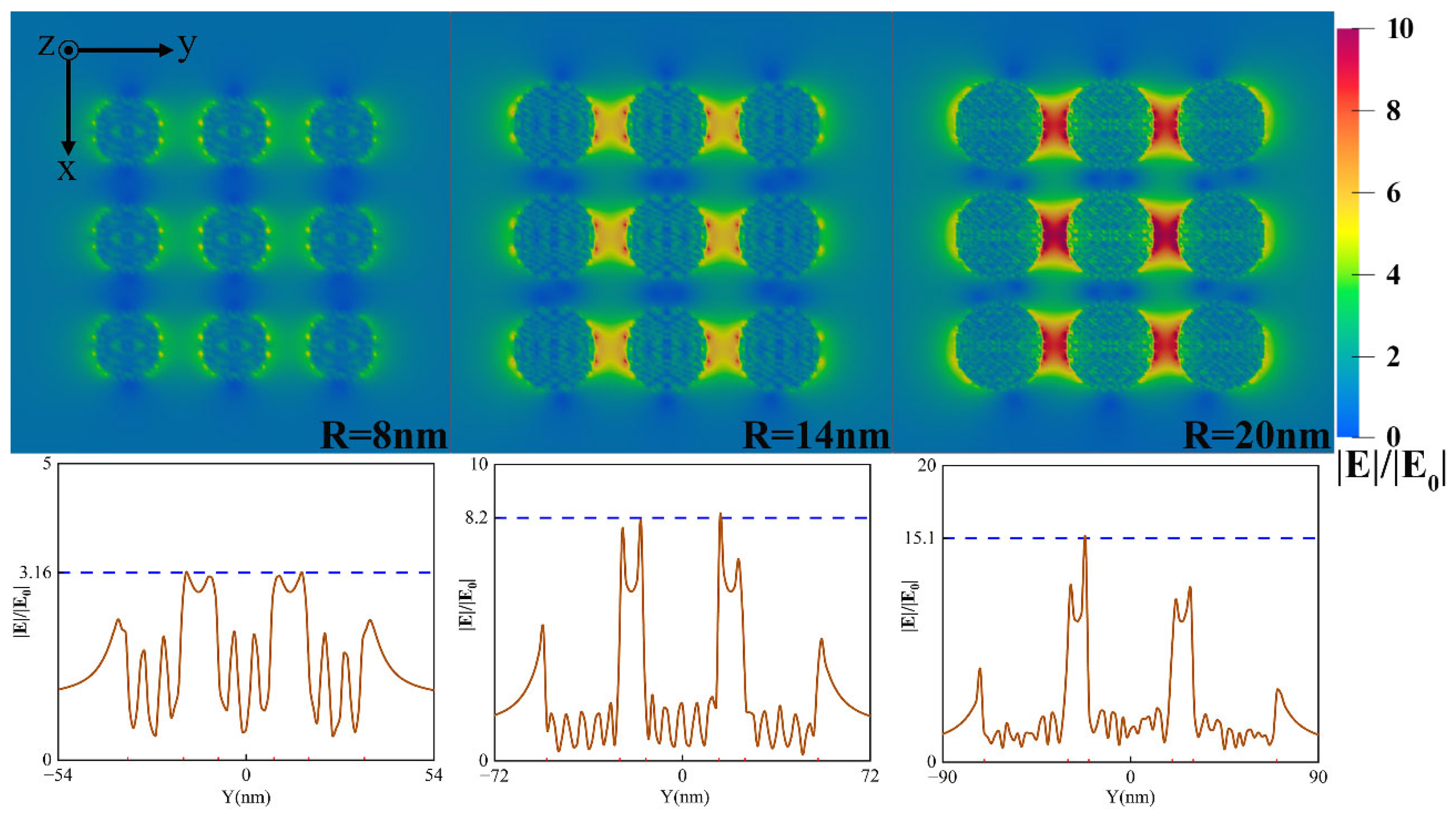
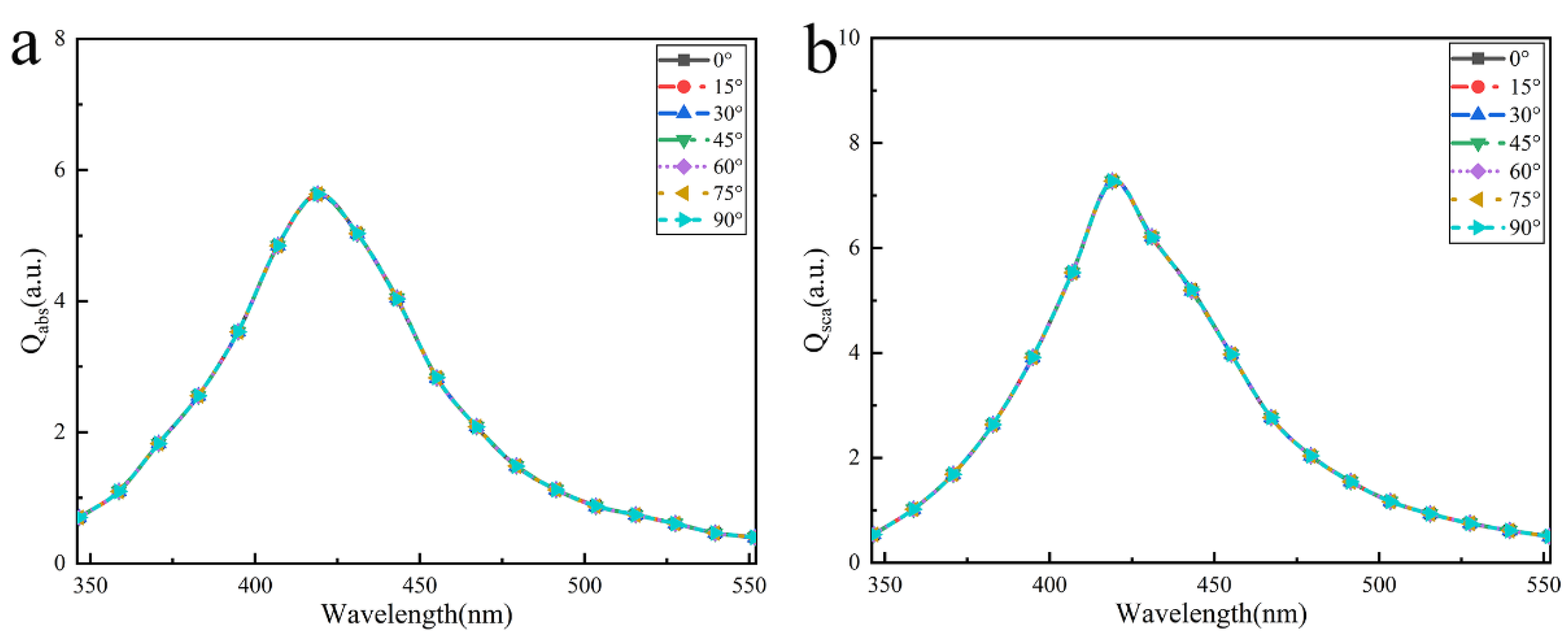
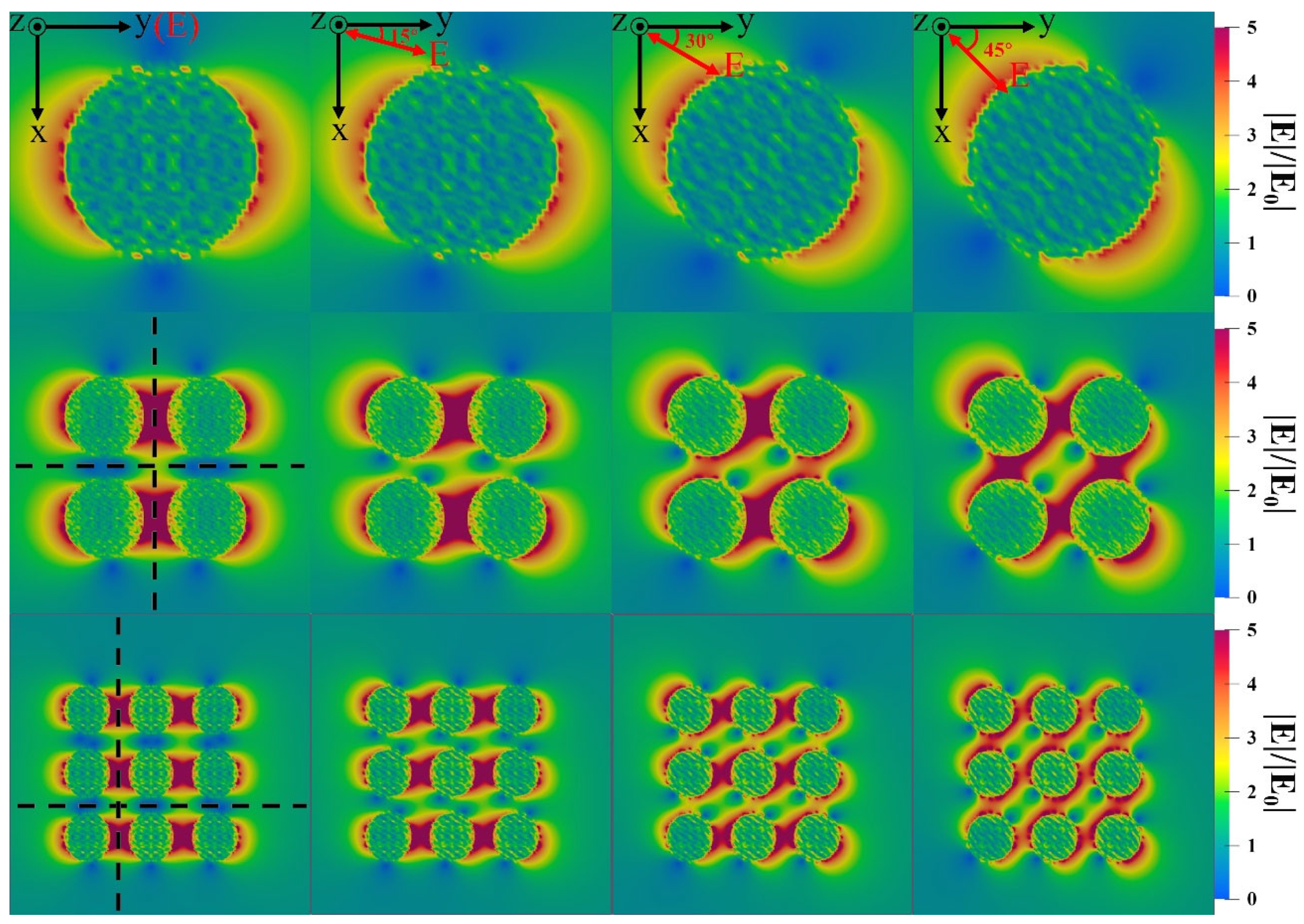

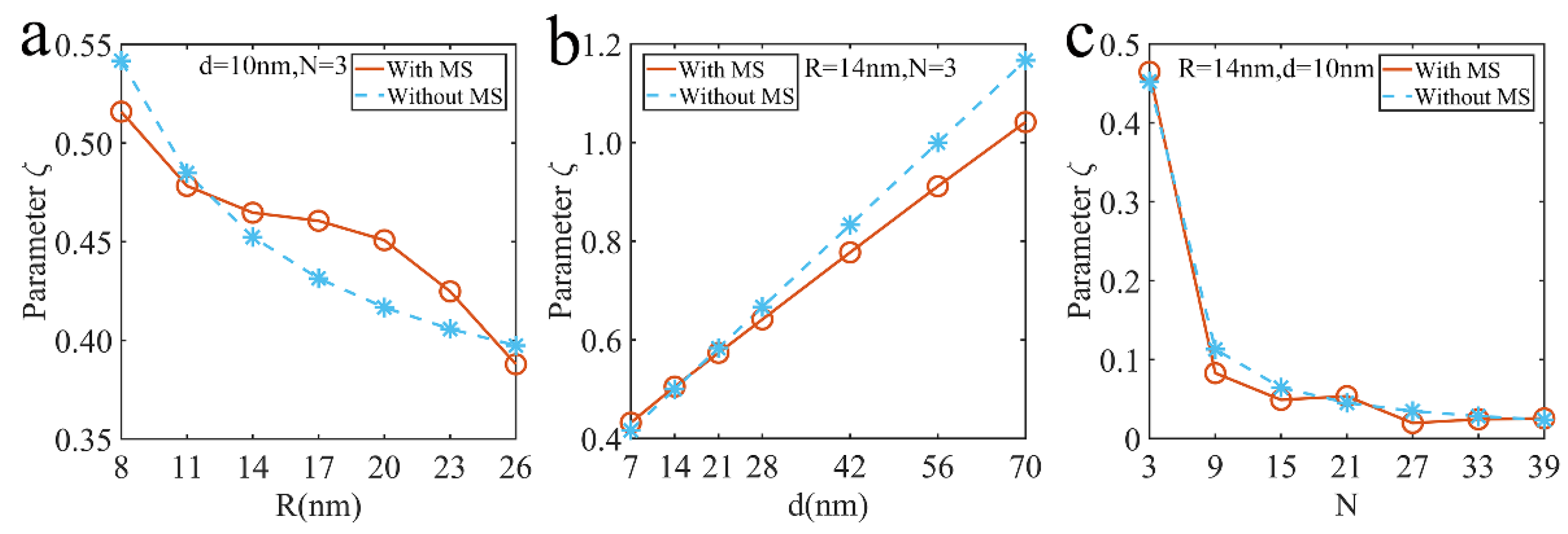
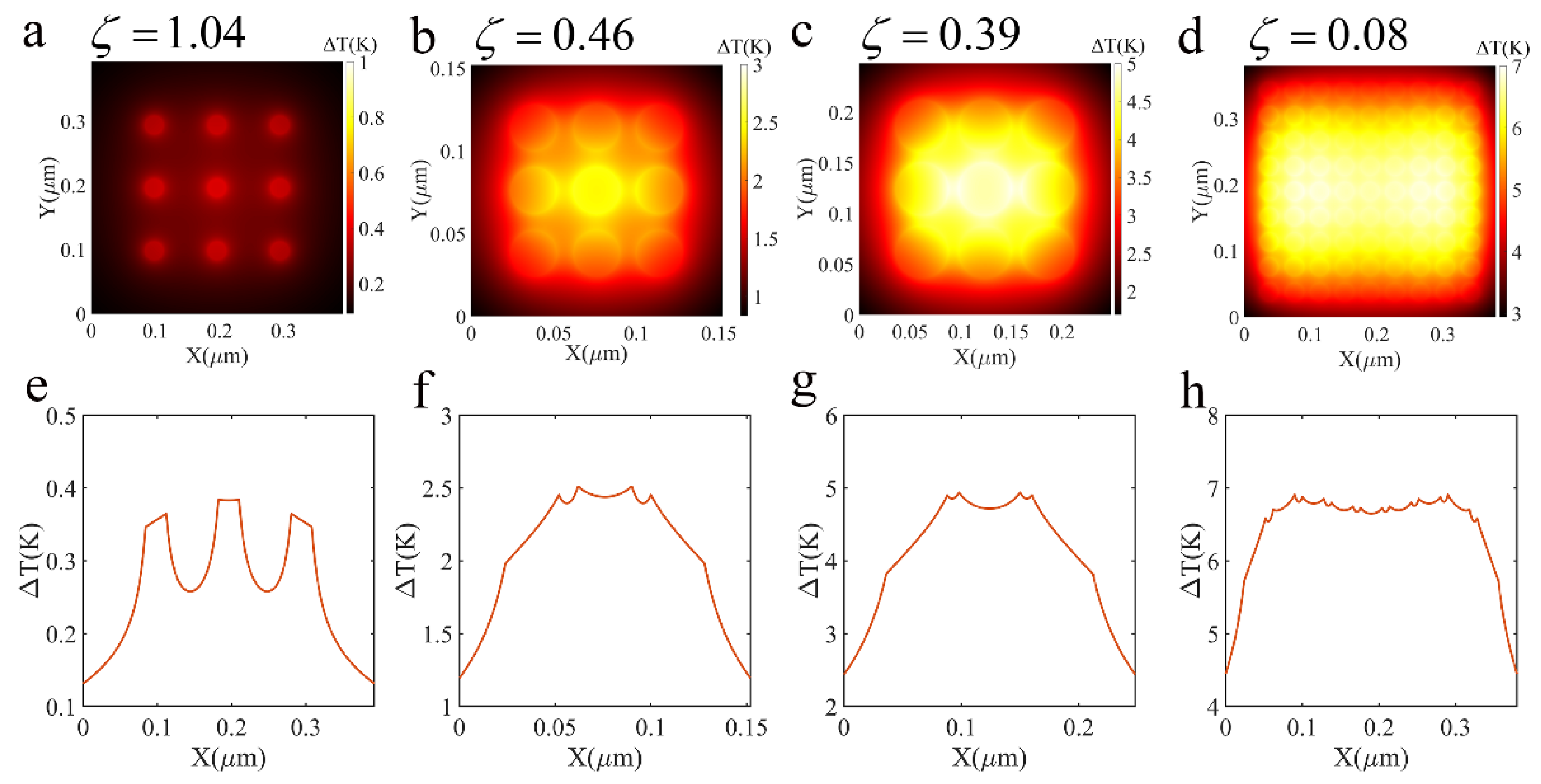
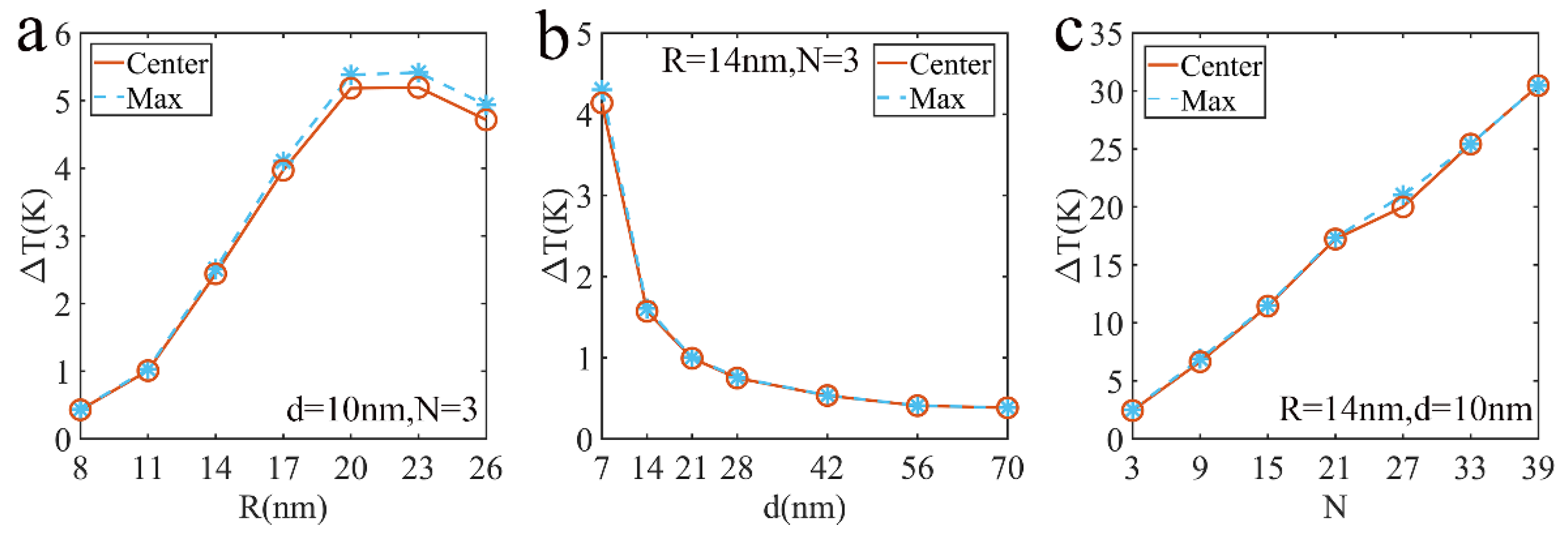

Publisher’s Note: MDPI stays neutral with regard to jurisdictional claims in published maps and institutional affiliations. |
© 2022 by the authors. Licensee MDPI, Basel, Switzerland. This article is an open access article distributed under the terms and conditions of the Creative Commons Attribution (CC BY) license (https://creativecommons.org/licenses/by/4.0/).
Share and Cite
Luo, D.; Hong, P.; Wu, C.; Wu, S.; Liu, X. Optical Properties of Ag Nanoparticle Arrays: Near-Field Enhancement and Photo-Thermal Temperature Distribution. Nanomaterials 2022, 12, 3924. https://doi.org/10.3390/nano12213924
Luo D, Hong P, Wu C, Wu S, Liu X. Optical Properties of Ag Nanoparticle Arrays: Near-Field Enhancement and Photo-Thermal Temperature Distribution. Nanomaterials. 2022; 12(21):3924. https://doi.org/10.3390/nano12213924
Chicago/Turabian StyleLuo, Daobin, Pengcheng Hong, Chao Wu, Shengbo Wu, and Xiaojing Liu. 2022. "Optical Properties of Ag Nanoparticle Arrays: Near-Field Enhancement and Photo-Thermal Temperature Distribution" Nanomaterials 12, no. 21: 3924. https://doi.org/10.3390/nano12213924
APA StyleLuo, D., Hong, P., Wu, C., Wu, S., & Liu, X. (2022). Optical Properties of Ag Nanoparticle Arrays: Near-Field Enhancement and Photo-Thermal Temperature Distribution. Nanomaterials, 12(21), 3924. https://doi.org/10.3390/nano12213924




